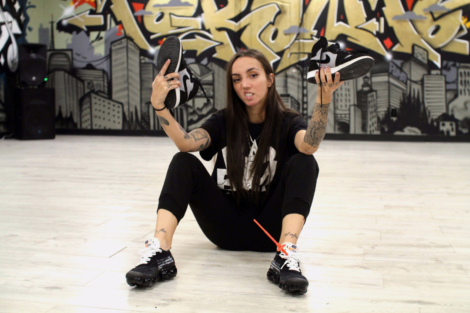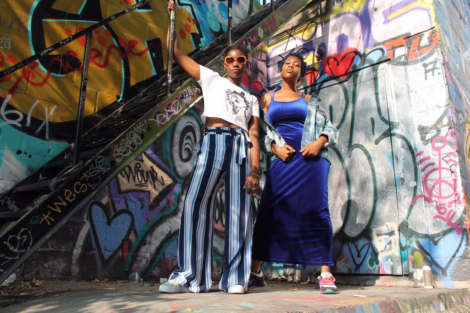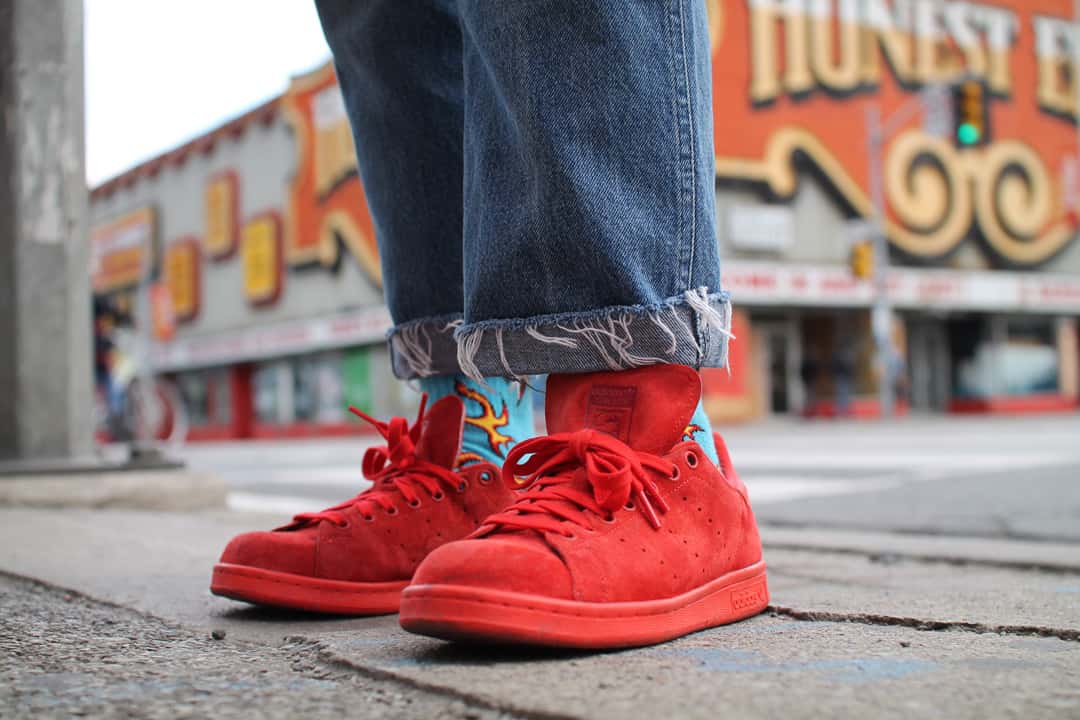Shoes are not neutral containers. Even if consumers are unaware of the sociopolitical, historical, and cultural baggage of their chosen footwear, they still tread on decades of meaning.
This phenomenon has been explored in different veins. Academics focus on the big abstract picture, examining, for example, the significance of increasing white desire for historic symbols of African American identity as manifested in Jordan-brand basketball shoes. Pop culture writers in the ever-growing community of sneakerheads — a nebulous social and consumer group fixated on the collection of desirable footwear — discuss the history of particular shoe releases and the intersections of mainstream culture with shoe culture.
These perspectives are not distinct patterns of inquiry. Through my conversations with sneakerheads, observers, and business owners, as well as engagement with academic writing on sneaker culture, I attempted to construct a holistic picture of what it really means to be active in shoe culture today.
What is shoe culture?
Sneaker culture itself is difficult to define. It exists between boundaries of consumerism and community; a cultural space with shifting characteristics and changing primary actors. Design student and shoe enthusiast Theo Richardson tells me that the sneaker scene “is just people who are keen to fit in and show off and own a piece of something larger than themselves.”
Travis Pereira, co-founder of she.lace, an online Toronto-based platform that highlights and celebrates women’s love for sneakers, agrees but adds that shoe culture can also offer an “opportunity for like-minded people to connect and build relationships.”
Although shoe culture can get a bad rap — he reminds me, after all, that he understands that they are “just sneakers” — Travis points to the value of “an industry developing two-way communication with its consumers [and] great collaborations with forward thinking creatives.”
Some devoted sneaker fans see the shoes themselves as art — albeit in an incredibly accessible and communicative form. Daniel Samuel, The Varsity’s Sports Editor, understands shoes in this way: “Shoes are fashion.”
But consumers also get to engage with history. When you buy a pair of Jordans, for example, you’re “wearing the shoes that Michael Jordan wore,” says Daniel. “You’re buying a part of history.”
Storytelling is another vital aspect of shoe culture, according to Theo. “Even though shoes are mass produced and stuff, they’re still selling you the story,” he explained. “If you’re looking at a Van Gogh, you feel a connection to that story. If you owned a Van Gogh, you’d have way more of a connection, because you own something that he touched.”
Clearly, shoe culture includes a wide variety of smaller factors, including a sense of community, engaged consumerism, athletics, art, and subculture influence. The one unifying aspect among all my interviewees, however, was a sincere reverence for and appreciation of shoes.
Where did shoe culture come from?
Sneakers were first designed for performance purposes in the nineteenth century, with a specific emphasis on tennis. The first basketball shoe was invented by The Converse Rubber Shoe Company in 1917 and named the All Star. The company used basketball players and coaches to endorse their shoes — such as Chuck Taylor himself — and Converse soon became the shoe of choice for basketball players.
In 1972, Nike entered the basketball shoe market with their leather and suede Nike Bruin. They were soon followed by other brands such as Puma. Around the same time Nike entered the market, the cultural meaning basketball itself began to shift, taking basketball shoes along with it.
The Atlantic quotes sneaker historian Bobbito Garcia’s explanation of this, who writes that “in the 1970s, New Yorkers in the basketball and hip-hop community changed the perception of sneakers from sports equipment to tools for cultural expression.” Furthermore, he adds, “the progenitors of sneaker culture were predominantly… kids of color who grew up in a depressed economic era.”
In the article, “Classic Campaigns — ‘It’s Gotta Be the Shoes’: Nike, Mike and Mars and the ‘Sneaker Killings’”, Texas Christian University researcher Catherine A. Coleman highlights that, alongside their relevance to sport, sneakers reflected “an aspirational lifestyle associated with of a variety of social forces including basketball and hip-hop that came together in urban environments in the 1980s.”
As American hip hop culture gained prominence in the 1980s — despite its villainization by mainly white critics who associated it with criminality — intersections increased between basketball shoes and hip hop artists. In 1986, hip hop group Run-DMC signed a million-dollar contract with Adidas, cementing the connection between shoe culture and hip hop.
Members of Run-DMC wore their Adidas Superstars without laces, which reflected the necessary style of prison footwear: shoelaces were removed for safety reasons. This is especially poignant considering the racial disparity between prison inmates — even today, Black men are far more likely to be imprisoned than white men in the United States.
Furthermore, Nike’s Air Force 1 soon became a status symbol among urban drug dealers and marginalized young men, which further linked sneaker culture to young, Black men. When then-rookie NBA player Michael Jordan signed with Nike in 1984, his Air Jordan line vastly expanded the market for basketball shoes.
Yet as Out of the Box: The Rise of Sneaker Culture explains, “many companies exploited the image of unrestrained urban luxury to sell shoes to white, suburban, middle-class consumers.” This commodification of ‘urban’ (read: Black) culture was made painfully clear in a media statement from former sneaker company British Knights: “the only way to get a middle-class suburban high school kid to buy your product is to have an inner-city kid wear it.”
Who participates?
The intentions of sneakerheads are vital — to be truly accepted and respected, a sneakerhead must be truly passionate about the shoes they purchase. They have to work to acquire them, know the history, and know the culture that surrounds them. These individuals make up one of the two main archetypes I encountered.
They are the self-perceived purists, who feel like they deserve to wear the goods they do. This group has set normative self-expectations, which mainly hinge on a sense of dedication to the history, the story, the athlete, and the hustle to find and afford exclusive shoes. However, they have to share space with the other dominant archetype — the hypebeast.
The hypebeast is characterized by significant wealth and a drive for the popular at any cost. Due to their financial advantage, they are able to buy the most exclusive shoe releases and products at extremely high prices — but not for the ‘right reasons.’
Theo illustrates this with a story. “I saw a dude the other day wearing a pair of shoes that are worth $800 and he’d kicked in the heel of them and was wearing them like slippers. He’d mashed the heel of them and obviously didn’t care about them at all.” He sighed heavily and looked at me from across the couch. “I think you should care about them.”
Leah Burchill, a journalism student at Carleton University, agrees with Theo. “It’s kind of the divide between actual style and just owning something, you know?” she told me over the phone. “It’s really easy for people to put a Supreme sweater and a pair of Yeezys and black jeans on, and sure they look good, but there’s not real personal style there.”
In this lens, hypebeasts are the antithesis to the purist; they follow trends blindly with little personal investment. Some purist sneakerheads worry that hypebeasts cheapen the overall culture, either through the enablement of reselling — which is the purchase of exclusive goods for resale at a significant mark-up — or by dominating the perception of sneaker culture.
Leah shared her concern, explaining that hypebeasts project a shallow image, that “it’s obvious that they just wanna seem cool and it’s easy for them because they’re rich.” Their flashier style and blatant consumerism can overshadow a more curated approach to streetwear culture and paint a monotone portrait of the overall scene.

PHOTO COURTESY OF she.lace
Yet despite the purists’ frustration with hypebeasts, today they are a vital organ in the body of shoe culture. In Theo’s words, “the hype is necessary to make people want what they want, and brands know that.”
Shoe culture and the mainstream
The dichotomy between hypebeast and purist is closely linked to the overall rise of shoe or streetwear culture in broader pop culture. Ushered in by celebrities such as Kanye West and Instagram influencers, shoes have taken on a new sense of cultural currency. Naj and Josh, co-owners of Ottawa-based streetwear store Stomping Ground, explain how this threatens the roots of streetwear culture.
“Streetwear culture was underground culture — it was rebellious culture,” says Naj. “Not so much today. Hip hop is the new pop, and in many ways streetwear culture is very mainstream now.”
Josh echoes his statement. Josh first got into shoes through the punk and hardcore scenes, inspired by figures like Scott Vogel from Terror, who is “a huge sneakerhead.”
“You used to have to mission to find certain things, and when you saw someone else wearing it you knew that we were outliers,” explains Naj. “You weren’t wearing American Eagle and Gap and things like that, so there’s definitely a common thread where you’re outside the mainstream.”
But today, as Josh succinctly puts it, “everyone knows what Bathing Ape is.” I did not know what Bathing Ape is. But I get the sentiment. I think.
Bleak as this mainstreaming may seem, it isn’t necessarily all bad news. Josh explains that “there’s always gonna be new artists, new designers and new brands that are emerging that keep you inspired and keep you excited about streetwear culture in general.”
Naj agrees. “As a brand matures and goes mainstream, it makes room for a new, younger, cooler brand to fill that space. It’s always ever changing; it’s not a static thing.”
Who is excluded?
In his “Provocations on Sneakers: The Multiple Significations of Athletic Shoes, Sport, Race, and Masculinity,” Michigan State University researcher Dylan AT Minder reminds readers that “in many regards, sneakers, as integral components of athletics, represented a dominant form of masculinity.” He argues that advertisers essentialize masculinity and create the products associated with this; since the nineteenth century, urban masculinity hinged on the fashioning of the male self as distinct from the feminine.
Furthermore, “since sport has historically been related to masculine social roles, the consumption of these products reaffirms the consumer’s identity as male.” Until very recently, major shoe brands, such as Nike and Adidas, failed to market goods to women, which demonstrates how they were “constricted by existing gender norms even while hegemonically replicating and developing them.”
That said, it is impossible to disentangle notions of gender from other questions about the role of race and socioeconomics in sneaker culture. While women are marginalized through patriarchal understandings of gender, the processes of racializing black men through athletic footwear are also vital avenues of inquiry and deserve more scholastic and cultural attention.
Nevertheless, women are increasingly active in shoe culture. Travis and his she.lace co-founder, Kiah Welsh, explained that they created their website to “carve out space within a community that has been, traditionally, exclusionary for women.” Josh and Naj agree with this diagnosis; Naj describes that “a lot of the the time, new releases only come in men’s sizes and then when they do women-specific colourways, they’re like overly girly or feminine.”

PHOTO COURTESY OF she.lace
Theo also spoke to this issue, pointing out that this functions as kind of vicious cycle as “masculine culture is continually perpetuated… The men are the ones wearing the shoes, so the men are the ones buying the shoes.”
Leah, also a sneakerhead, builds on this idea to explain that “it’s not that women are not interested, it’s that they’re not interested in what [major shoe brands] are creating for women.”
Travis and Kiah believe that in order for this to change, major brands need to “speak to women as equal participants in the sneaker community” instead of pandering to their perceived pastel desires.
Furthermore, very few women hold significant leadership positions in shoe design. Leah and Theo both told me that more women need to be empowered to move into this roles, otherwise shoes will continue to be “designed for men by men,” as Theo puts it.
What shoe culture tells us
Hypebeasts and purists are united in their pursuit of consumption — whatever their deeper motivation may be. Prices for specific shoes, such as Virgil Abloh’s Off-White Jordan 1, can climb over $2000 — not to mention designer shoes created by established houses, such as Prada or Louis Vuitton, which clock in even higher. This is a significant departure from the shoe culture of the ‘80s, and points to a kind of cultural gentrification on the part of the economically successful.
On the other end of the spectrum, women are much better represented in shoe culture today, which could point to the possibility of dismantling the male hegemony over athleticism and shoe culture.
In their postcolonial study of sneakers and street culture, Monash University researchers Janice Brace-Govan and Hélène de Burgh-Woodman argue that “sneakers have come to provide a way for the urban culture to garner a sense of both individual and collective identity.” Furthermore, the increasing popularity of sneaker culture allow the urban, Black communities that white suburbanites find both threatening and attractive to set cultural tones and give brands or specific goods credibility.
This is clear even in the example of superstars such as Kanye West. But is this as liberating as it sounds? Although sneakers may empower individuals or communities to challenge negative stereotypes and forge new identities, their actual emancipatory power is limited as long as we live in a capitalist society built on gendered and racialized hierarchies of value.


